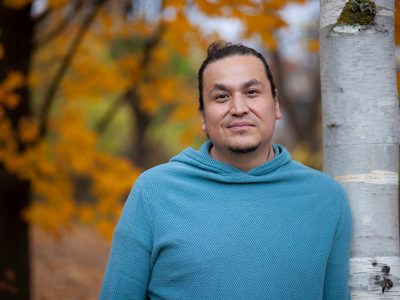By Dan Rubinstein
Photos by Chris Roussakis
The birchbark canoe is an iconic symbol of Algonquin culture. It’s also a remarkably effective yet elegantly simple piece of technology. And it looks beautiful.
To help celebrate Carleton’s 75th anniversary, the university’s Centre for Aboriginal Culture and Education (CACE) and the Carleton University Art Gallery (CUAG) have decided to collaborate on a project that will bring students together to build a birchbark canoe using traditional materials and methods.
“It’s an opportunity for cross-cultural and experiential learning,” says Benny Michaud, one of CACE’s three Aboriginal Cultural Liaison Officers, “and it’s another way to acknowledge that Carleton is located upon and within unceded Algonquin territory.”
Michaud was responsible for recruiting the students who will build the canoe under the direction of Pinock, an internationally-renowned Algonquin craftsman from the Kitigan Zibi Anishinabeg Nation, about two hours north of Ottawa. The group, a mix of Indigenous and non-Indigenous students, will assemble the canoe on Wednesday evenings at CUAG until late March.
Algonquin craftsman Pinock (centre) is giving Carleton students a hands-on lesson in canoe construction.
When it’s finished, the eight- or nine-foot canoe will be tested in the water and, next fall, will be installed in a prominent place on the main floor of the MacOdrum Library.
“There was a lot of interest from students,” says Michaud.
“They’re always keen to be involved in culturally relevant educational opportunities.
“Experiential learning is a central part of Indigenous cultures,” she continues. “That’s how communities passed on traditional knowledge from one generation to the next. There’s not necessarily a lot of instruction, but there’s a lot of demonstration.”
For the Indigenous students working on the canoe, says Michaud, this a chance to reconnect with their culture. For the non-Indigenous students, it’s an opportunity to experience a traditional way of sharing knowledge.
Indigenous cultures
are very much alive
“Some may think of Indigenous cultures as being part of a distant past with no contemporary presence. But our cultures are alive. These types of projects demonstrate the resilience we have, and our intrinsic and intimate relationship with the land.”
Pinock, who also builds toboggans, paddles, drums and snowshoes, made his first birchbark canoe about 25 years ago with help from an uncle who was in his 80s.
“I learned from the school of life,” says Pinock, who had watched his grandfather and other relatives make canoes when he was a young child. “I’m definitely not self-taught. I learned from the community as a whole.”
![]()
In the 1950s, he says, there wasn’t much work in Kitigan Zibi, so people harvested trees from the surrounding forests to make canoes, paddles, toboggans and other objects they needed for their daily lives.
“Today, a few people still know how to make these things, but not many do it actively,” says Pinock.
“Today, people have the interest, but they don’t have the time to devote to it. People get caught up in the pace of modern life. That’s not just in our culture — it’s everybody. It’s the times we’re living in.”
Pinock follows his trapline in Réserve faunique La Vérendrye northwest of Kitigan Zibi to gather materials for his canoes. He looks for straight, knot-free birch trees about two or three feet in diameter, then removes a small piece of the outer bark to check it for flexibility — a step that does not harm the trees he leaves standing.
The most difficult part of building a birchbark canoe, he says, is finding good materials. All you need are the bark, cedar and ash wood for the frame, spruce roots to lash the pieces together, and spruce gum to seal it. Once you have these, the canoe comes together fairly easily because the design is so simple.
“Remember, my ancestors did things without metal tools,” says Pinock, “though they did have virgin forests and healthy trees.
“This type of canoe is something that comes directly from nature. The students who do these things, they really get involved. It’s an experience that helps them appreciate native culture, when they see how simple it is. Humans are strange animals. We like complicated things. This is a very simple vessel.”
Pinock, who doesn’t consider himself a master canoe builder, describing himself as “an Algonquin guy who makes stuff,” hasn’t counted the number of canoes he has built over the years. But he has noticed an increasing interest in traditional practice, and has made canoes with groups of students as far away as New York City, and one that’s installed at the Canada Council for the Arts headquarters in downtown Ottawa.
“Hands-on learning is the best way to learn,” he says. “I want the students to do as much as they can. I’m there to show them the basics and how to use the tools. I’m there to help, not to sit around and give orders.
Birchbark canoe project
goes beyond construction
“It’s not really the canoe that’s important. It’s learning how to build it, and learning how to communicate with each other.
“It’s also very important to maintain our traditions. We’ve lost a lot of our culture in the last 50 or 60 years. We need this. Culture is who we are. It helps us appreciate the ingenuity and intelligence of our ancestors.”
CUAG director Sandra Dyck first met Pinock in fall 2015 when the gallery hosted “Walking With Our Sisters,” a memorial installation in honour of Missing and Murdered Indigenous Women, Girls, and Two-Spirit People.
Early last year, when a canoe project was discussed as a means of marking Carleton’s 75th anniversary, Dyck thought of Pinock.
“It’s very important for the gallery, and for Carleton, to honour and support diverse forms of knowledge, like that of Pinock, who talks about learning from his elders, his community and the ‘school of life,’” says Dyck.
“The canoe, as a work in progress, will be left on display in the gallery. The public will be able to see this incredible work of art and technology come together.
“Working with and learning from Pinock to make a canoe is not only a huge honour, it is also a wonderful opportunity for what we call ‘collaborative co-learning in public.’ We are keen to create spaces of exchange and reflection in the gallery, and to encourage active participation. Everyone brings their own experiences and knowledge to the gallery, and we aspire to learn together.”
One of Pinock’s finished birchbark canoes, on display in the Canada Council for the Arts office in downtown Ottawa. (Photo: Sandra Dyck)
Carleton President Roseann O’Reilly Runte has been an enthusiastic supporter of the canoe project since its inception. She strives to bring a new work of art to campus every year, and wanted to do something special for the 75th anniversary.
“Art plays an important role in our lives, transmitting ideas and emotions, culture and knowledge,” says Runte.
“It challenges us to think and helps us transcend the routine and to discover the extraordinary.
“Art may bring us beauty and serenity, or jar our senses and disturb our thoughts, making us question the superficial and seek deep meaning. I believe that art should be an important part of our lives and our education, and hope that the members of the Carleton community will share my enthusiasm and agree that these works of art add to our campus and its meaning.”
Thursday, February 16, 2017 in Art Gallery, CU Anniversaries, Indigenous
Share: Twitter, Facebook




